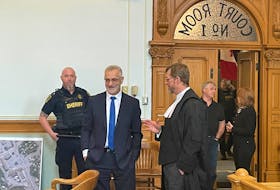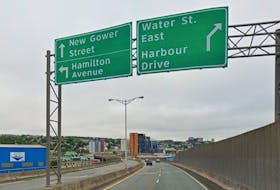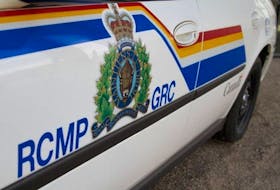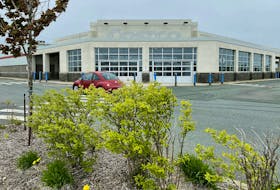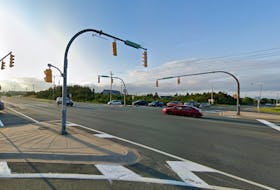It is Hermitage sometime in the late 1800s or early 1900s and the hand-written note says, “The homemade pieced bed quilt often comes in handy for bringing in the hay in the Newfoundland outports, where horses are unknown.”
The picture was taken by Connecticut, U.S., photographer Edith Watson, who visited Newfoundland for almost 30 summers, the later years with her life partner, Bermudian-born journalist Victoria Hayward, with whom she travelled openly.
Watson chronicled the lives and work of women and girls during her travels here, taking thousands of photographs between the rough time period of 1891 to 1913 and possibly into the 1920s. Many times, she left photos and cameras behind as payment for board, says her biographer.
Now Toronto author Frances Rooney needs help from people in Newfoundland with her latest project on the groundbreaking photographer. The book, expected to come out next year, is about Edith Watson’s work — somewhat ahead of its time in that she concentrated on documenting women, young girls and children in Newfoundland, mostly in rural areas.
“I know this is a long shot,” Rooney said.
Rooney, author of a book about Watson titled “Working Light,” is trying to fill in the blanks on about 100 photos she has in her collection of Watson’s photographs, as well as more details on what family, community and work life was like for the women and children depicted in the photos.
“Clearly from the photographs, it seemed pretty clear she had quite a cordial relationship with the people she was photographing,” Rooney said.
“At least some of them, and maybe a lot, this was the first photo taken of them.”
In 2009, Rooney was in Newfoundland to tell the story of Watson, whose photographic legacy was recognized by the provincial archives for not only depicting the lives of rural Newfoundland families at the turn of the 20th century, but emphasizing the day-to-day work of women at the time.
Watson made her living as a freelance photographer, and though she travelled extensively around Canada, the U.S. and other parts of the world, she was head over heels about Newfoundland and Labrador, and returned every year for 20 years, and sporadically after that. She initially travelled with her sister, Amelia, an artist.
In 1911, she met Hayward.
Rooney’s interest in Watson was tweaked in the 1970s, when she came across a photograph depicting a Magdalen Islands woman at a loom in a 1916 magazine.
The photograph was credited, which was unusual for early pictures, but Rooney eventually learned Watson was a serious businesswoman who insisted on credits so she could get more work.
Rooney, through the widow of Watson’s cousin, gained access to Watson’s documents and albums, Hayward’s later diaries and Amelia Watson’s diaries.
As Watson’s travels predated the prevalence of auto travel, she lugged cumbersome early camera equipment and large glass negatives.
Local papers would announce Watson’s arrival and whom she was boarding with.
As Watson left a trail of photographs wherever she went, and Rooney suspects there are many still left in Newfoundland, as she often gave copies to people she photographed.
“A loaded Kodak camera with 100 pictures and mailed back to Kodak cost about $20, a considerable amount of money in that time,” Rooney said.
“She used those kinds of cameras and I don’t know what she left behind.”
They were sometimes stamped “Edith Watson, East Windsor Hill, Connecticut,” and that marker may still exist on the backs of photos, but may have gone unnoticed if the photos have been in frames or albums for decades.
Because Hayward did not travel with Watson to Newfoundland and Labrador until later on, there weren’t many detailed notes left with the photos — only handwritten captions on some. Hayward’s diaries from her time coming to the province, if there were any, are lost.
Rooney said Hayward would have stood out in people’s memories — not only because she was Bermudian, but she was pretty and genial.
In the early 1980s, negatives of some of Watson’s photos were found in a house that was being demolished in Quidi Vidi.
Watson would sell her photos to magazines and newspapers in the U.S., Canada and Bermuda. She also did a couple of travel brochures for the Newfoundland government, Rooney said.
And in 1922, Watson and Hayward wrote a photo-illustrated travel book, “Romantic Canada,” in which the phrase “Canadian mosaic” was coined. Although confederation with Canada was more than two decades away, the book included the Crown colony of Newfoundland.
Her body of work also includes a chronicle of the Doukhobors, a religious farming sect in western Canada. Though she travelled to North America, the Caribbean and Mexico, Watson maintained her base at the family home in Connecticut, spending major holidays there, along with extended summers in Newfoundland and winters in Bermuda.
Watson died in 1943.
Anyone who has stories to tell that have been passed down through family regarding Watson, or has photos, or may be able to identify people in photos, can contact Rooney at [email protected] or by traditional mail at 59 Oakcrest Ave., Toronto, ON, M4C 1B4
Twitter: @bsweettweets
A trail of photographs
Places where Edith Watson photographed (late 1800s-early 1900s)
Batteau (Labrador)
Bay of Islands
Belleoram
Burgeo
Burin
Cape Ray
Codroy Valley-Tompkins-Little River
Exploits
Ferry landing at the Doucets’
Fogo Island
Fortune Harbour
Harbour Breton
Hermitage
Hopedale (Labrador)
La Scie
Nipper’s Harbour
Notre Dame Bay
Partridge Island
Path End
Penguin Head bound for Goose Arm
Petrie’s Point, Birchy Cove, Bay of Islands
Petty Harbour
Placentia Bay
Quidi Vidi
St John’s
Shore Cove
Snook’s Arm
Tompkins
Venison Tickle (Labrador)
White Bear (Labrador)
People
Partial names of people she photographed:
Mary Hannaford, Petty Harbour
Mr. and Mrs. Joseph Batstone and Lovey
Mrs. Petrie, Petrie’s Point
Mr. and Mrs. Cook, Fortune Harbour
Mrs. Joseph Francis, Hermitage
Capt. Borland (off Penguin Head bound for Goose Arm, Sept. 8, 1902)
Uncle Tom [Borland?] and Lovey
Doucets
It is Hermitage sometime in the late 1800s or early 1900s and the hand-written note says, “The homemade pieced bed quilt often comes in handy for bringing in the hay in the Newfoundland outports, where horses are unknown.”
The picture was taken by Connecticut, U.S., photographer Edith Watson, who visited Newfoundland for almost 30 summers, the later years with her life partner, Bermudian-born journalist Victoria Hayward, with whom she travelled openly.
Watson chronicled the lives and work of women and girls during her travels here, taking thousands of photographs between the rough time period of 1891 to 1913 and possibly into the 1920s. Many times, she left photos and cameras behind as payment for board, says her biographer.
Now Toronto author Frances Rooney needs help from people in Newfoundland with her latest project on the groundbreaking photographer. The book, expected to come out next year, is about Edith Watson’s work — somewhat ahead of its time in that she concentrated on documenting women, young girls and children in Newfoundland, mostly in rural areas.
“I know this is a long shot,” Rooney said.
Rooney, author of a book about Watson titled “Working Light,” is trying to fill in the blanks on about 100 photos she has in her collection of Watson’s photographs, as well as more details on what family, community and work life was like for the women and children depicted in the photos.
“Clearly from the photographs, it seemed pretty clear she had quite a cordial relationship with the people she was photographing,” Rooney said.
“At least some of them, and maybe a lot, this was the first photo taken of them.”
In 2009, Rooney was in Newfoundland to tell the story of Watson, whose photographic legacy was recognized by the provincial archives for not only depicting the lives of rural Newfoundland families at the turn of the 20th century, but emphasizing the day-to-day work of women at the time.
Watson made her living as a freelance photographer, and though she travelled extensively around Canada, the U.S. and other parts of the world, she was head over heels about Newfoundland and Labrador, and returned every year for 20 years, and sporadically after that. She initially travelled with her sister, Amelia, an artist.
In 1911, she met Hayward.
Rooney’s interest in Watson was tweaked in the 1970s, when she came across a photograph depicting a Magdalen Islands woman at a loom in a 1916 magazine.
The photograph was credited, which was unusual for early pictures, but Rooney eventually learned Watson was a serious businesswoman who insisted on credits so she could get more work.
Rooney, through the widow of Watson’s cousin, gained access to Watson’s documents and albums, Hayward’s later diaries and Amelia Watson’s diaries.
As Watson’s travels predated the prevalence of auto travel, she lugged cumbersome early camera equipment and large glass negatives.
Local papers would announce Watson’s arrival and whom she was boarding with.
As Watson left a trail of photographs wherever she went, and Rooney suspects there are many still left in Newfoundland, as she often gave copies to people she photographed.
“A loaded Kodak camera with 100 pictures and mailed back to Kodak cost about $20, a considerable amount of money in that time,” Rooney said.
“She used those kinds of cameras and I don’t know what she left behind.”
They were sometimes stamped “Edith Watson, East Windsor Hill, Connecticut,” and that marker may still exist on the backs of photos, but may have gone unnoticed if the photos have been in frames or albums for decades.
Because Hayward did not travel with Watson to Newfoundland and Labrador until later on, there weren’t many detailed notes left with the photos — only handwritten captions on some. Hayward’s diaries from her time coming to the province, if there were any, are lost.
Rooney said Hayward would have stood out in people’s memories — not only because she was Bermudian, but she was pretty and genial.
In the early 1980s, negatives of some of Watson’s photos were found in a house that was being demolished in Quidi Vidi.
Watson would sell her photos to magazines and newspapers in the U.S., Canada and Bermuda. She also did a couple of travel brochures for the Newfoundland government, Rooney said.
And in 1922, Watson and Hayward wrote a photo-illustrated travel book, “Romantic Canada,” in which the phrase “Canadian mosaic” was coined. Although confederation with Canada was more than two decades away, the book included the Crown colony of Newfoundland.
Her body of work also includes a chronicle of the Doukhobors, a religious farming sect in western Canada. Though she travelled to North America, the Caribbean and Mexico, Watson maintained her base at the family home in Connecticut, spending major holidays there, along with extended summers in Newfoundland and winters in Bermuda.
Watson died in 1943.
Anyone who has stories to tell that have been passed down through family regarding Watson, or has photos, or may be able to identify people in photos, can contact Rooney at [email protected] or by traditional mail at 59 Oakcrest Ave., Toronto, ON, M4C 1B4
Twitter: @bsweettweets
A trail of photographs
Places where Edith Watson photographed (late 1800s-early 1900s)
Batteau (Labrador)
Bay of Islands
Belleoram
Burgeo
Burin
Cape Ray
Codroy Valley-Tompkins-Little River
Exploits
Ferry landing at the Doucets’
Fogo Island
Fortune Harbour
Harbour Breton
Hermitage
Hopedale (Labrador)
La Scie
Nipper’s Harbour
Notre Dame Bay
Partridge Island
Path End
Penguin Head bound for Goose Arm
Petrie’s Point, Birchy Cove, Bay of Islands
Petty Harbour
Placentia Bay
Quidi Vidi
St John’s
Shore Cove
Snook’s Arm
Tompkins
Venison Tickle (Labrador)
White Bear (Labrador)
People
Partial names of people she photographed:
Mary Hannaford, Petty Harbour
Mr. and Mrs. Joseph Batstone and Lovey
Mrs. Petrie, Petrie’s Point
Mr. and Mrs. Cook, Fortune Harbour
Mrs. Joseph Francis, Hermitage
Capt. Borland (off Penguin Head bound for Goose Arm, Sept. 8, 1902)
Uncle Tom [Borland?] and Lovey
Doucets



